Detailed Contract Law Analysis: Assignment on Key Legal Concepts
VerifiedAdded on 2019/12/18
|10
|3423
|364
Homework Assignment
AI Summary
This assignment solution delves into the core principles of contract law, elucidating the essential elements required for a valid contract, including offer, acceptance, consideration, and intention. It differentiates between an offer and an invitation to treat, referencing key case laws such as Pharmaceutical Society v Boots and Fisher v Bell. The document further categorizes various types of contracts, such as face-to-face, bilateral, unilateral, written, distance selling, and oral contracts, providing clarity on their distinct characteristics. Moreover, it examines the different types of contract terms, including express, conditions, warranties, innominate, and implied terms, and their implications in contract performance and breach. The assignment also analyzes a scenario involving an invitation to treat and an exclusion clause, applying legal principles from cases like Carlill v Carbolic Smoke Ball and Chapelton v Barry UDC to determine the validity and enforceability of the contract and its terms.
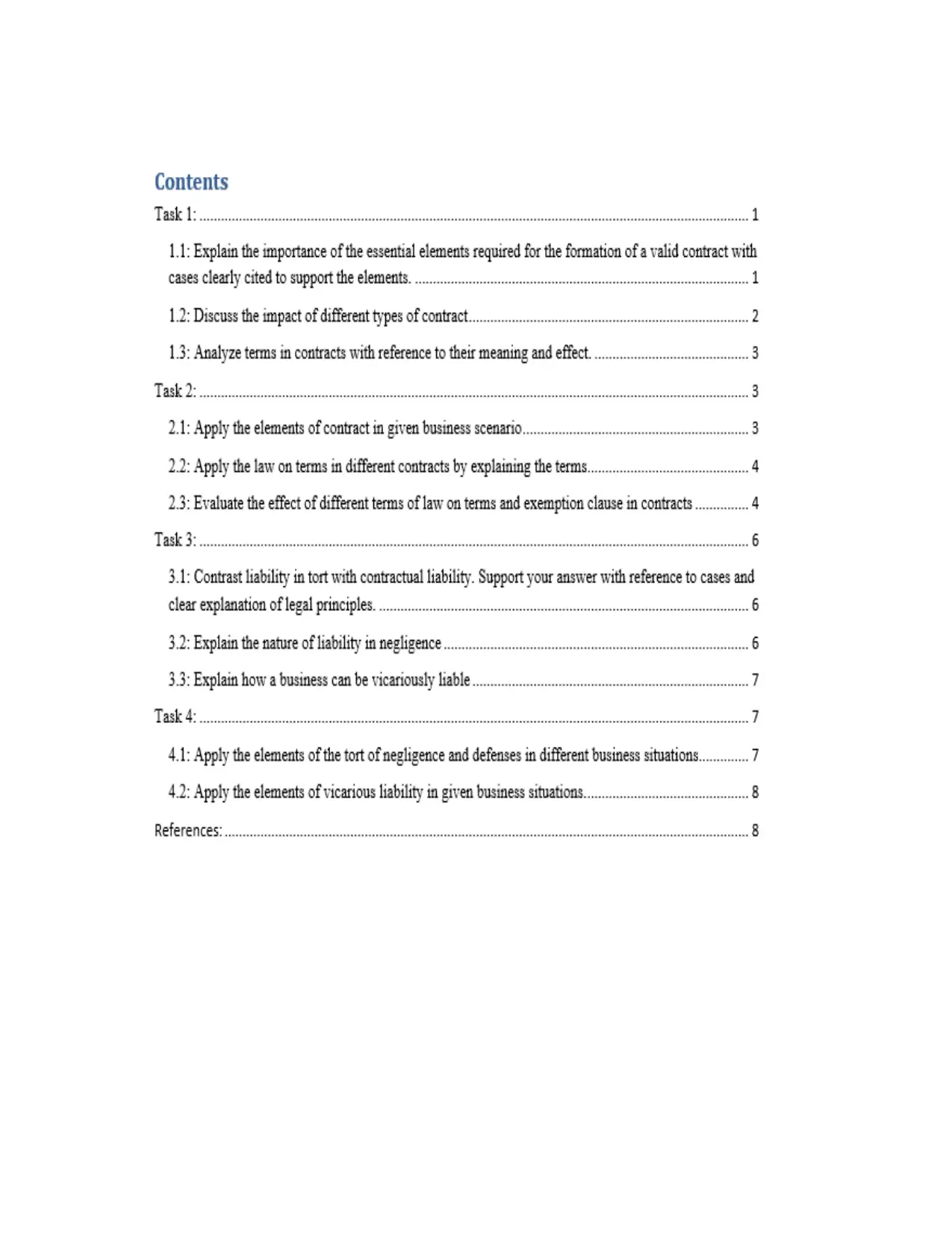
Paraphrase This Document
Need a fresh take? Get an instant paraphrase of this document with our AI Paraphraser
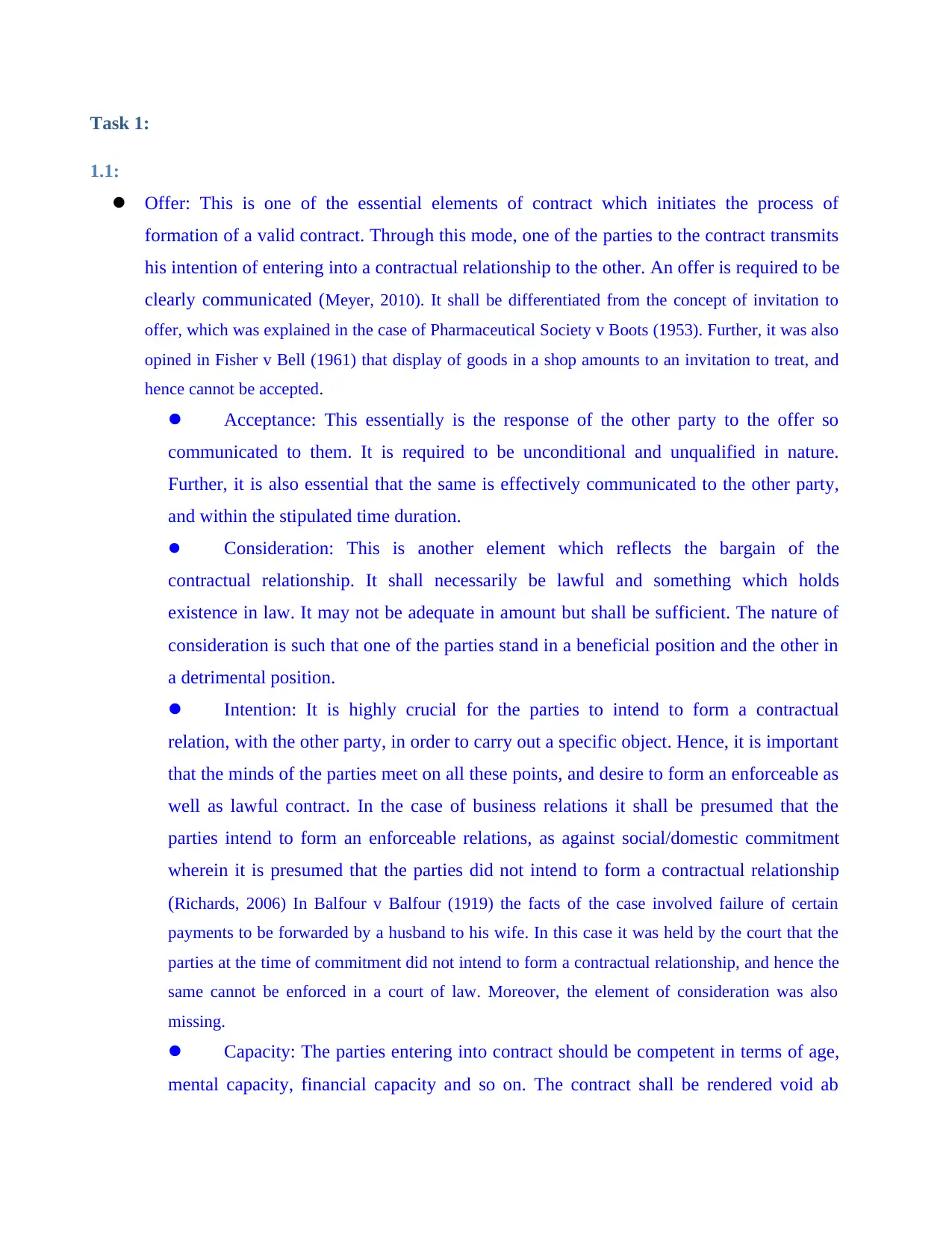
Task 1:
1.1:
Offer: This is one of the essential elements of contract which initiates the process of
formation of a valid contract. Through this mode, one of the parties to the contract transmits
his intention of entering into a contractual relationship to the other. An offer is required to be
clearly communicated (Meyer, 2010). It shall be differentiated from the concept of invitation to
offer, which was explained in the case of Pharmaceutical Society v Boots (1953). Further, it was also
opined in Fisher v Bell (1961) that display of goods in a shop amounts to an invitation to treat, and
hence cannot be accepted.
Acceptance: This essentially is the response of the other party to the offer so
communicated to them. It is required to be unconditional and unqualified in nature.
Further, it is also essential that the same is effectively communicated to the other party,
and within the stipulated time duration.
Consideration: This is another element which reflects the bargain of the
contractual relationship. It shall necessarily be lawful and something which holds
existence in law. It may not be adequate in amount but shall be sufficient. The nature of
consideration is such that one of the parties stand in a beneficial position and the other in
a detrimental position.
Intention: It is highly crucial for the parties to intend to form a contractual
relation, with the other party, in order to carry out a specific object. Hence, it is important
that the minds of the parties meet on all these points, and desire to form an enforceable as
well as lawful contract. In the case of business relations it shall be presumed that the
parties intend to form an enforceable relations, as against social/domestic commitment
wherein it is presumed that the parties did not intend to form a contractual relationship
(Richards, 2006) In Balfour v Balfour (1919) the facts of the case involved failure of certain
payments to be forwarded by a husband to his wife. In this case it was held by the court that the
parties at the time of commitment did not intend to form a contractual relationship, and hence the
same cannot be enforced in a court of law. Moreover, the element of consideration was also
missing.
Capacity: The parties entering into contract should be competent in terms of age,
mental capacity, financial capacity and so on. The contract shall be rendered void ab
1.1:
Offer: This is one of the essential elements of contract which initiates the process of
formation of a valid contract. Through this mode, one of the parties to the contract transmits
his intention of entering into a contractual relationship to the other. An offer is required to be
clearly communicated (Meyer, 2010). It shall be differentiated from the concept of invitation to
offer, which was explained in the case of Pharmaceutical Society v Boots (1953). Further, it was also
opined in Fisher v Bell (1961) that display of goods in a shop amounts to an invitation to treat, and
hence cannot be accepted.
Acceptance: This essentially is the response of the other party to the offer so
communicated to them. It is required to be unconditional and unqualified in nature.
Further, it is also essential that the same is effectively communicated to the other party,
and within the stipulated time duration.
Consideration: This is another element which reflects the bargain of the
contractual relationship. It shall necessarily be lawful and something which holds
existence in law. It may not be adequate in amount but shall be sufficient. The nature of
consideration is such that one of the parties stand in a beneficial position and the other in
a detrimental position.
Intention: It is highly crucial for the parties to intend to form a contractual
relation, with the other party, in order to carry out a specific object. Hence, it is important
that the minds of the parties meet on all these points, and desire to form an enforceable as
well as lawful contract. In the case of business relations it shall be presumed that the
parties intend to form an enforceable relations, as against social/domestic commitment
wherein it is presumed that the parties did not intend to form a contractual relationship
(Richards, 2006) In Balfour v Balfour (1919) the facts of the case involved failure of certain
payments to be forwarded by a husband to his wife. In this case it was held by the court that the
parties at the time of commitment did not intend to form a contractual relationship, and hence the
same cannot be enforced in a court of law. Moreover, the element of consideration was also
missing.
Capacity: The parties entering into contract should be competent in terms of age,
mental capacity, financial capacity and so on. The contract shall be rendered void ab
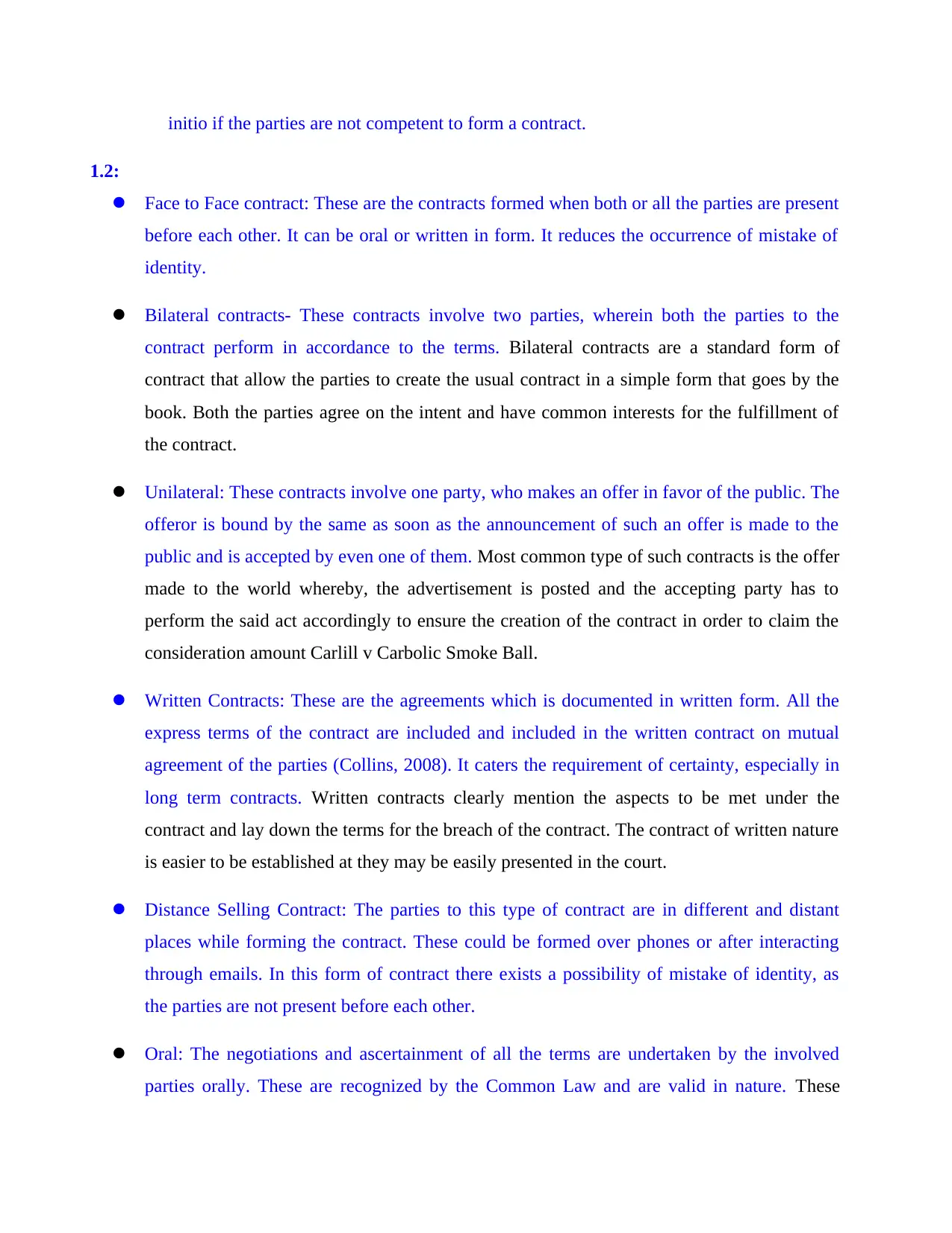
initio if the parties are not competent to form a contract.
1.2:
Face to Face contract: These are the contracts formed when both or all the parties are present
before each other. It can be oral or written in form. It reduces the occurrence of mistake of
identity.
Bilateral contracts- These contracts involve two parties, wherein both the parties to the
contract perform in accordance to the terms. Bilateral contracts are a standard form of
contract that allow the parties to create the usual contract in a simple form that goes by the
book. Both the parties agree on the intent and have common interests for the fulfillment of
the contract.
Unilateral: These contracts involve one party, who makes an offer in favor of the public. The
offeror is bound by the same as soon as the announcement of such an offer is made to the
public and is accepted by even one of them. Most common type of such contracts is the offer
made to the world whereby, the advertisement is posted and the accepting party has to
perform the said act accordingly to ensure the creation of the contract in order to claim the
consideration amount Carlill v Carbolic Smoke Ball.
Written Contracts: These are the agreements which is documented in written form. All the
express terms of the contract are included and included in the written contract on mutual
agreement of the parties (Collins, 2008). It caters the requirement of certainty, especially in
long term contracts. Written contracts clearly mention the aspects to be met under the
contract and lay down the terms for the breach of the contract. The contract of written nature
is easier to be established at they may be easily presented in the court.
Distance Selling Contract: The parties to this type of contract are in different and distant
places while forming the contract. These could be formed over phones or after interacting
through emails. In this form of contract there exists a possibility of mistake of identity, as
the parties are not present before each other.
Oral: The negotiations and ascertainment of all the terms are undertaken by the involved
parties orally. These are recognized by the Common Law and are valid in nature. These
1.2:
Face to Face contract: These are the contracts formed when both or all the parties are present
before each other. It can be oral or written in form. It reduces the occurrence of mistake of
identity.
Bilateral contracts- These contracts involve two parties, wherein both the parties to the
contract perform in accordance to the terms. Bilateral contracts are a standard form of
contract that allow the parties to create the usual contract in a simple form that goes by the
book. Both the parties agree on the intent and have common interests for the fulfillment of
the contract.
Unilateral: These contracts involve one party, who makes an offer in favor of the public. The
offeror is bound by the same as soon as the announcement of such an offer is made to the
public and is accepted by even one of them. Most common type of such contracts is the offer
made to the world whereby, the advertisement is posted and the accepting party has to
perform the said act accordingly to ensure the creation of the contract in order to claim the
consideration amount Carlill v Carbolic Smoke Ball.
Written Contracts: These are the agreements which is documented in written form. All the
express terms of the contract are included and included in the written contract on mutual
agreement of the parties (Collins, 2008). It caters the requirement of certainty, especially in
long term contracts. Written contracts clearly mention the aspects to be met under the
contract and lay down the terms for the breach of the contract. The contract of written nature
is easier to be established at they may be easily presented in the court.
Distance Selling Contract: The parties to this type of contract are in different and distant
places while forming the contract. These could be formed over phones or after interacting
through emails. In this form of contract there exists a possibility of mistake of identity, as
the parties are not present before each other.
Oral: The negotiations and ascertainment of all the terms are undertaken by the involved
parties orally. These are recognized by the Common Law and are valid in nature. These
⊘ This is a preview!⊘
Do you want full access?
Subscribe today to unlock all pages.

Trusted by 1+ million students worldwide
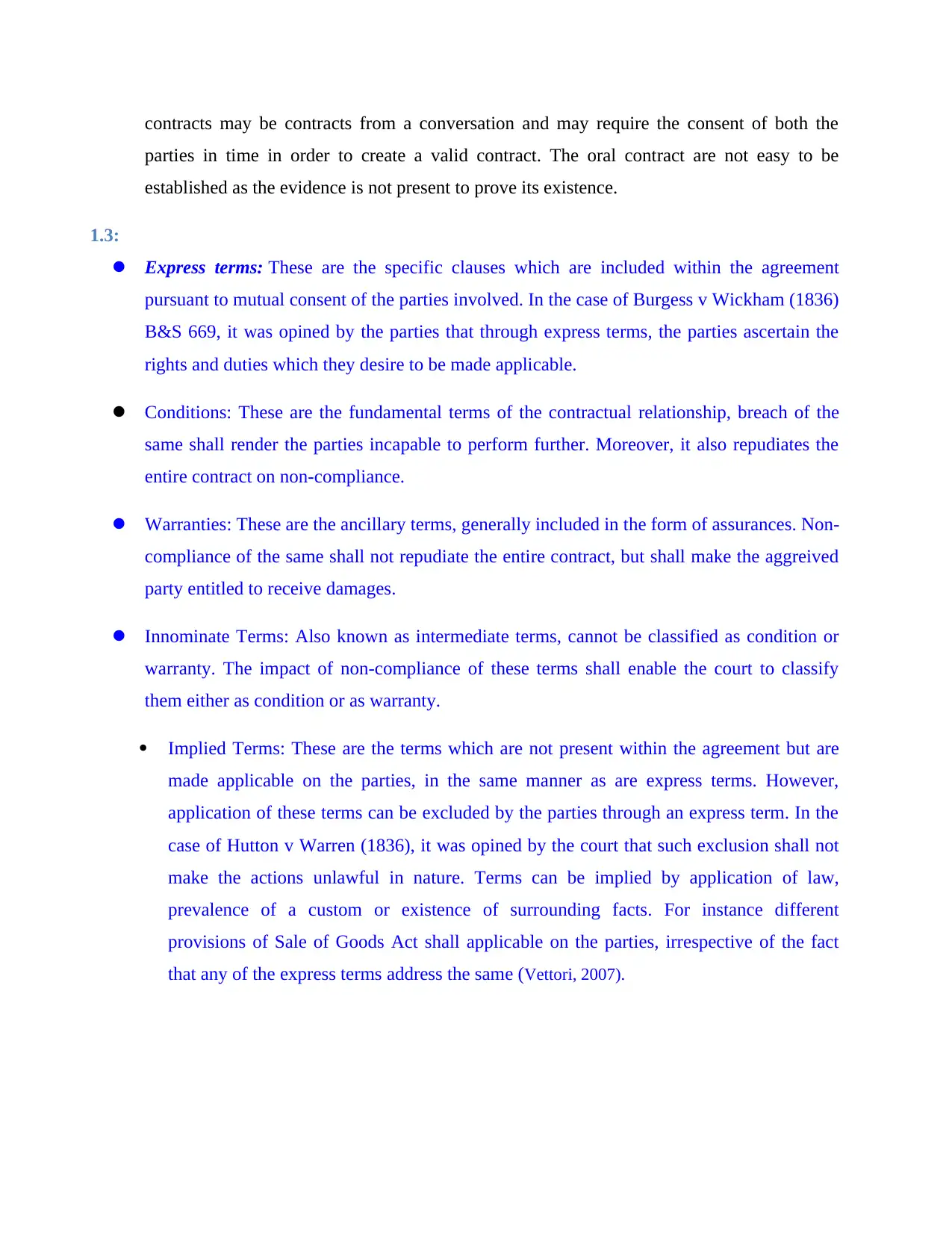
contracts may be contracts from a conversation and may require the consent of both the
parties in time in order to create a valid contract. The oral contract are not easy to be
established as the evidence is not present to prove its existence.
1.3:
Express terms: These are the specific clauses which are included within the agreement
pursuant to mutual consent of the parties involved. In the case of Burgess v Wickham (1836)
B&S 669, it was opined by the parties that through express terms, the parties ascertain the
rights and duties which they desire to be made applicable.
Conditions: These are the fundamental terms of the contractual relationship, breach of the
same shall render the parties incapable to perform further. Moreover, it also repudiates the
entire contract on non-compliance.
Warranties: These are the ancillary terms, generally included in the form of assurances. Non-
compliance of the same shall not repudiate the entire contract, but shall make the aggreived
party entitled to receive damages.
Innominate Terms: Also known as intermediate terms, cannot be classified as condition or
warranty. The impact of non-compliance of these terms shall enable the court to classify
them either as condition or as warranty.
Implied Terms: These are the terms which are not present within the agreement but are
made applicable on the parties, in the same manner as are express terms. However,
application of these terms can be excluded by the parties through an express term. In the
case of Hutton v Warren (1836), it was opined by the court that such exclusion shall not
make the actions unlawful in nature. Terms can be implied by application of law,
prevalence of a custom or existence of surrounding facts. For instance different
provisions of Sale of Goods Act shall applicable on the parties, irrespective of the fact
that any of the express terms address the same (Vettori, 2007).
parties in time in order to create a valid contract. The oral contract are not easy to be
established as the evidence is not present to prove its existence.
1.3:
Express terms: These are the specific clauses which are included within the agreement
pursuant to mutual consent of the parties involved. In the case of Burgess v Wickham (1836)
B&S 669, it was opined by the parties that through express terms, the parties ascertain the
rights and duties which they desire to be made applicable.
Conditions: These are the fundamental terms of the contractual relationship, breach of the
same shall render the parties incapable to perform further. Moreover, it also repudiates the
entire contract on non-compliance.
Warranties: These are the ancillary terms, generally included in the form of assurances. Non-
compliance of the same shall not repudiate the entire contract, but shall make the aggreived
party entitled to receive damages.
Innominate Terms: Also known as intermediate terms, cannot be classified as condition or
warranty. The impact of non-compliance of these terms shall enable the court to classify
them either as condition or as warranty.
Implied Terms: These are the terms which are not present within the agreement but are
made applicable on the parties, in the same manner as are express terms. However,
application of these terms can be excluded by the parties through an express term. In the
case of Hutton v Warren (1836), it was opined by the court that such exclusion shall not
make the actions unlawful in nature. Terms can be implied by application of law,
prevalence of a custom or existence of surrounding facts. For instance different
provisions of Sale of Goods Act shall applicable on the parties, irrespective of the fact
that any of the express terms address the same (Vettori, 2007).
Paraphrase This Document
Need a fresh take? Get an instant paraphrase of this document with our AI Paraphraser
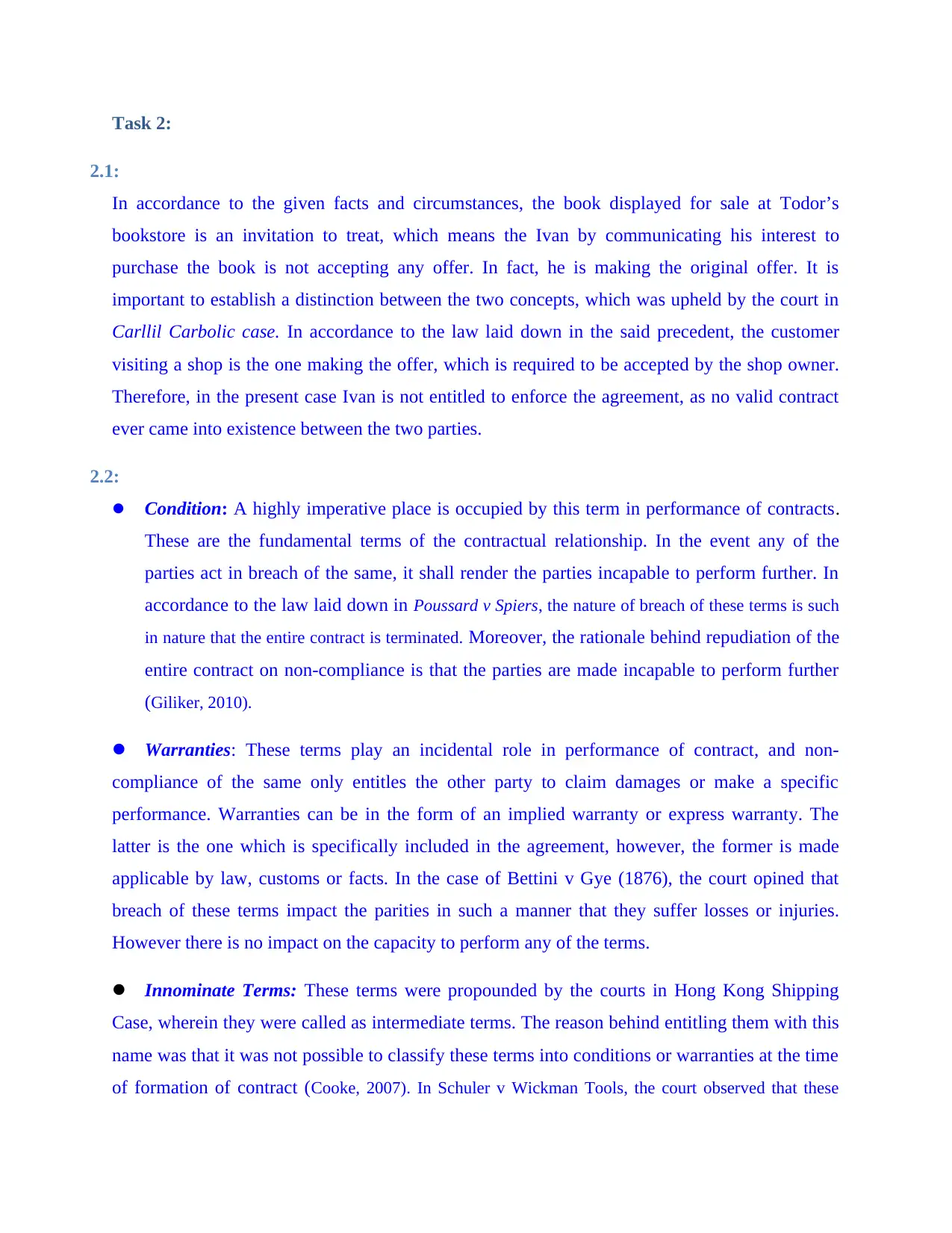
Task 2:
2.1:
In accordance to the given facts and circumstances, the book displayed for sale at Todor’s
bookstore is an invitation to treat, which means the Ivan by communicating his interest to
purchase the book is not accepting any offer. In fact, he is making the original offer. It is
important to establish a distinction between the two concepts, which was upheld by the court in
Carllil Carbolic case. In accordance to the law laid down in the said precedent, the customer
visiting a shop is the one making the offer, which is required to be accepted by the shop owner.
Therefore, in the present case Ivan is not entitled to enforce the agreement, as no valid contract
ever came into existence between the two parties.
2.2:
Condition: A highly imperative place is occupied by this term in performance of contracts.
These are the fundamental terms of the contractual relationship. In the event any of the
parties act in breach of the same, it shall render the parties incapable to perform further. In
accordance to the law laid down in Poussard v Spiers, the nature of breach of these terms is such
in nature that the entire contract is terminated. Moreover, the rationale behind repudiation of the
entire contract on non-compliance is that the parties are made incapable to perform further
(Giliker, 2010).
Warranties: These terms play an incidental role in performance of contract, and non-
compliance of the same only entitles the other party to claim damages or make a specific
performance. Warranties can be in the form of an implied warranty or express warranty. The
latter is the one which is specifically included in the agreement, however, the former is made
applicable by law, customs or facts. In the case of Bettini v Gye (1876), the court opined that
breach of these terms impact the parities in such a manner that they suffer losses or injuries.
However there is no impact on the capacity to perform any of the terms.
Innominate Terms: These terms were propounded by the courts in Hong Kong Shipping
Case, wherein they were called as intermediate terms. The reason behind entitling them with this
name was that it was not possible to classify these terms into conditions or warranties at the time
of formation of contract (Cooke, 2007). In Schuler v Wickman Tools, the court observed that these
2.1:
In accordance to the given facts and circumstances, the book displayed for sale at Todor’s
bookstore is an invitation to treat, which means the Ivan by communicating his interest to
purchase the book is not accepting any offer. In fact, he is making the original offer. It is
important to establish a distinction between the two concepts, which was upheld by the court in
Carllil Carbolic case. In accordance to the law laid down in the said precedent, the customer
visiting a shop is the one making the offer, which is required to be accepted by the shop owner.
Therefore, in the present case Ivan is not entitled to enforce the agreement, as no valid contract
ever came into existence between the two parties.
2.2:
Condition: A highly imperative place is occupied by this term in performance of contracts.
These are the fundamental terms of the contractual relationship. In the event any of the
parties act in breach of the same, it shall render the parties incapable to perform further. In
accordance to the law laid down in Poussard v Spiers, the nature of breach of these terms is such
in nature that the entire contract is terminated. Moreover, the rationale behind repudiation of the
entire contract on non-compliance is that the parties are made incapable to perform further
(Giliker, 2010).
Warranties: These terms play an incidental role in performance of contract, and non-
compliance of the same only entitles the other party to claim damages or make a specific
performance. Warranties can be in the form of an implied warranty or express warranty. The
latter is the one which is specifically included in the agreement, however, the former is made
applicable by law, customs or facts. In the case of Bettini v Gye (1876), the court opined that
breach of these terms impact the parities in such a manner that they suffer losses or injuries.
However there is no impact on the capacity to perform any of the terms.
Innominate Terms: These terms were propounded by the courts in Hong Kong Shipping
Case, wherein they were called as intermediate terms. The reason behind entitling them with this
name was that it was not possible to classify these terms into conditions or warranties at the time
of formation of contract (Cooke, 2007). In Schuler v Wickman Tools, the court observed that these
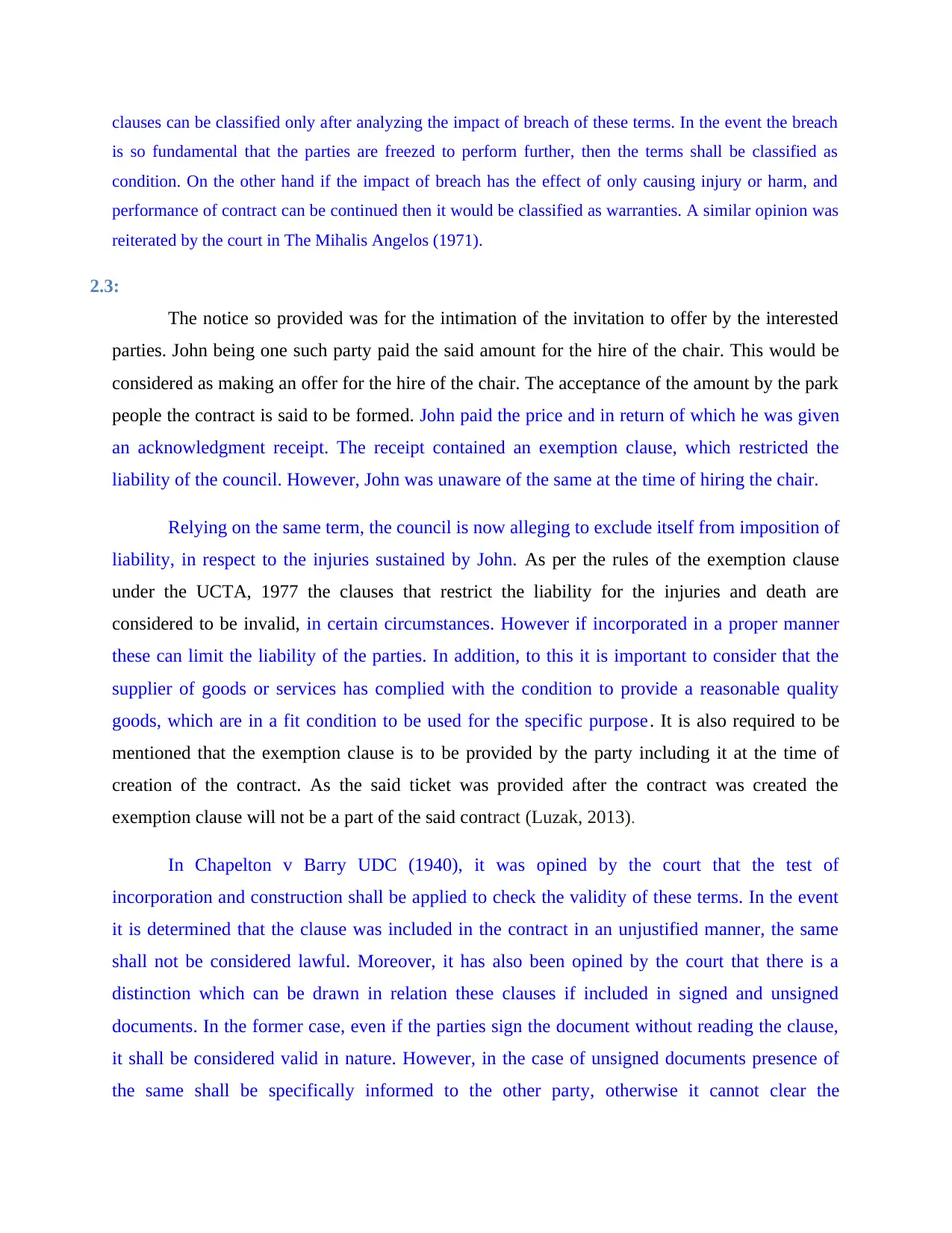
clauses can be classified only after analyzing the impact of breach of these terms. In the event the breach
is so fundamental that the parties are freezed to perform further, then the terms shall be classified as
condition. On the other hand if the impact of breach has the effect of only causing injury or harm, and
performance of contract can be continued then it would be classified as warranties. A similar opinion was
reiterated by the court in The Mihalis Angelos (1971).
2.3:
The notice so provided was for the intimation of the invitation to offer by the interested
parties. John being one such party paid the said amount for the hire of the chair. This would be
considered as making an offer for the hire of the chair. The acceptance of the amount by the park
people the contract is said to be formed. John paid the price and in return of which he was given
an acknowledgment receipt. The receipt contained an exemption clause, which restricted the
liability of the council. However, John was unaware of the same at the time of hiring the chair.
Relying on the same term, the council is now alleging to exclude itself from imposition of
liability, in respect to the injuries sustained by John. As per the rules of the exemption clause
under the UCTA, 1977 the clauses that restrict the liability for the injuries and death are
considered to be invalid, in certain circumstances. However if incorporated in a proper manner
these can limit the liability of the parties. In addition, to this it is important to consider that the
supplier of goods or services has complied with the condition to provide a reasonable quality
goods, which are in a fit condition to be used for the specific purpose. It is also required to be
mentioned that the exemption clause is to be provided by the party including it at the time of
creation of the contract. As the said ticket was provided after the contract was created the
exemption clause will not be a part of the said contract (Luzak, 2013).
In Chapelton v Barry UDC (1940), it was opined by the court that the test of
incorporation and construction shall be applied to check the validity of these terms. In the event
it is determined that the clause was included in the contract in an unjustified manner, the same
shall not be considered lawful. Moreover, it has also been opined by the court that there is a
distinction which can be drawn in relation these clauses if included in signed and unsigned
documents. In the former case, even if the parties sign the document without reading the clause,
it shall be considered valid in nature. However, in the case of unsigned documents presence of
the same shall be specifically informed to the other party, otherwise it cannot clear the
is so fundamental that the parties are freezed to perform further, then the terms shall be classified as
condition. On the other hand if the impact of breach has the effect of only causing injury or harm, and
performance of contract can be continued then it would be classified as warranties. A similar opinion was
reiterated by the court in The Mihalis Angelos (1971).
2.3:
The notice so provided was for the intimation of the invitation to offer by the interested
parties. John being one such party paid the said amount for the hire of the chair. This would be
considered as making an offer for the hire of the chair. The acceptance of the amount by the park
people the contract is said to be formed. John paid the price and in return of which he was given
an acknowledgment receipt. The receipt contained an exemption clause, which restricted the
liability of the council. However, John was unaware of the same at the time of hiring the chair.
Relying on the same term, the council is now alleging to exclude itself from imposition of
liability, in respect to the injuries sustained by John. As per the rules of the exemption clause
under the UCTA, 1977 the clauses that restrict the liability for the injuries and death are
considered to be invalid, in certain circumstances. However if incorporated in a proper manner
these can limit the liability of the parties. In addition, to this it is important to consider that the
supplier of goods or services has complied with the condition to provide a reasonable quality
goods, which are in a fit condition to be used for the specific purpose. It is also required to be
mentioned that the exemption clause is to be provided by the party including it at the time of
creation of the contract. As the said ticket was provided after the contract was created the
exemption clause will not be a part of the said contract (Luzak, 2013).
In Chapelton v Barry UDC (1940), it was opined by the court that the test of
incorporation and construction shall be applied to check the validity of these terms. In the event
it is determined that the clause was included in the contract in an unjustified manner, the same
shall not be considered lawful. Moreover, it has also been opined by the court that there is a
distinction which can be drawn in relation these clauses if included in signed and unsigned
documents. In the former case, even if the parties sign the document without reading the clause,
it shall be considered valid in nature. However, in the case of unsigned documents presence of
the same shall be specifically informed to the other party, otherwise it cannot clear the
⊘ This is a preview!⊘
Do you want full access?
Subscribe today to unlock all pages.

Trusted by 1+ million students worldwide
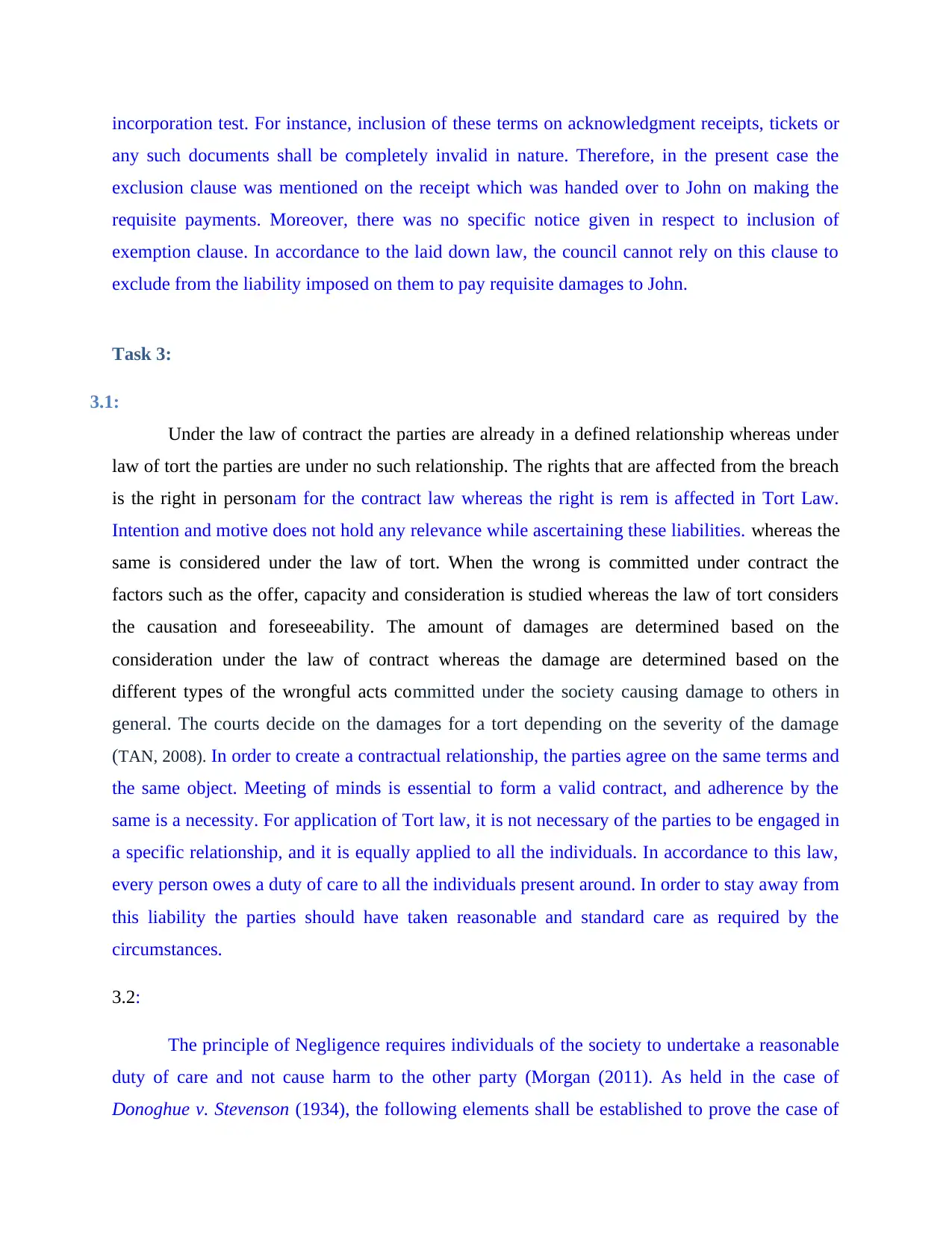
incorporation test. For instance, inclusion of these terms on acknowledgment receipts, tickets or
any such documents shall be completely invalid in nature. Therefore, in the present case the
exclusion clause was mentioned on the receipt which was handed over to John on making the
requisite payments. Moreover, there was no specific notice given in respect to inclusion of
exemption clause. In accordance to the laid down law, the council cannot rely on this clause to
exclude from the liability imposed on them to pay requisite damages to John.
Task 3:
3.1:
Under the law of contract the parties are already in a defined relationship whereas under
law of tort the parties are under no such relationship. The rights that are affected from the breach
is the right in personam for the contract law whereas the right is rem is affected in Tort Law.
Intention and motive does not hold any relevance while ascertaining these liabilities. whereas the
same is considered under the law of tort. When the wrong is committed under contract the
factors such as the offer, capacity and consideration is studied whereas the law of tort considers
the causation and foreseeability. The amount of damages are determined based on the
consideration under the law of contract whereas the damage are determined based on the
different types of the wrongful acts committed under the society causing damage to others in
general. The courts decide on the damages for a tort depending on the severity of the damage
(TAN, 2008). In order to create a contractual relationship, the parties agree on the same terms and
the same object. Meeting of minds is essential to form a valid contract, and adherence by the
same is a necessity. For application of Tort law, it is not necessary of the parties to be engaged in
a specific relationship, and it is equally applied to all the individuals. In accordance to this law,
every person owes a duty of care to all the individuals present around. In order to stay away from
this liability the parties should have taken reasonable and standard care as required by the
circumstances.
3.2:
The principle of Negligence requires individuals of the society to undertake a reasonable
duty of care and not cause harm to the other party (Morgan (2011). As held in the case of
Donoghue v. Stevenson (1934), the following elements shall be established to prove the case of
any such documents shall be completely invalid in nature. Therefore, in the present case the
exclusion clause was mentioned on the receipt which was handed over to John on making the
requisite payments. Moreover, there was no specific notice given in respect to inclusion of
exemption clause. In accordance to the laid down law, the council cannot rely on this clause to
exclude from the liability imposed on them to pay requisite damages to John.
Task 3:
3.1:
Under the law of contract the parties are already in a defined relationship whereas under
law of tort the parties are under no such relationship. The rights that are affected from the breach
is the right in personam for the contract law whereas the right is rem is affected in Tort Law.
Intention and motive does not hold any relevance while ascertaining these liabilities. whereas the
same is considered under the law of tort. When the wrong is committed under contract the
factors such as the offer, capacity and consideration is studied whereas the law of tort considers
the causation and foreseeability. The amount of damages are determined based on the
consideration under the law of contract whereas the damage are determined based on the
different types of the wrongful acts committed under the society causing damage to others in
general. The courts decide on the damages for a tort depending on the severity of the damage
(TAN, 2008). In order to create a contractual relationship, the parties agree on the same terms and
the same object. Meeting of minds is essential to form a valid contract, and adherence by the
same is a necessity. For application of Tort law, it is not necessary of the parties to be engaged in
a specific relationship, and it is equally applied to all the individuals. In accordance to this law,
every person owes a duty of care to all the individuals present around. In order to stay away from
this liability the parties should have taken reasonable and standard care as required by the
circumstances.
3.2:
The principle of Negligence requires individuals of the society to undertake a reasonable
duty of care and not cause harm to the other party (Morgan (2011). As held in the case of
Donoghue v. Stevenson (1934), the following elements shall be established to prove the case of
Paraphrase This Document
Need a fresh take? Get an instant paraphrase of this document with our AI Paraphraser
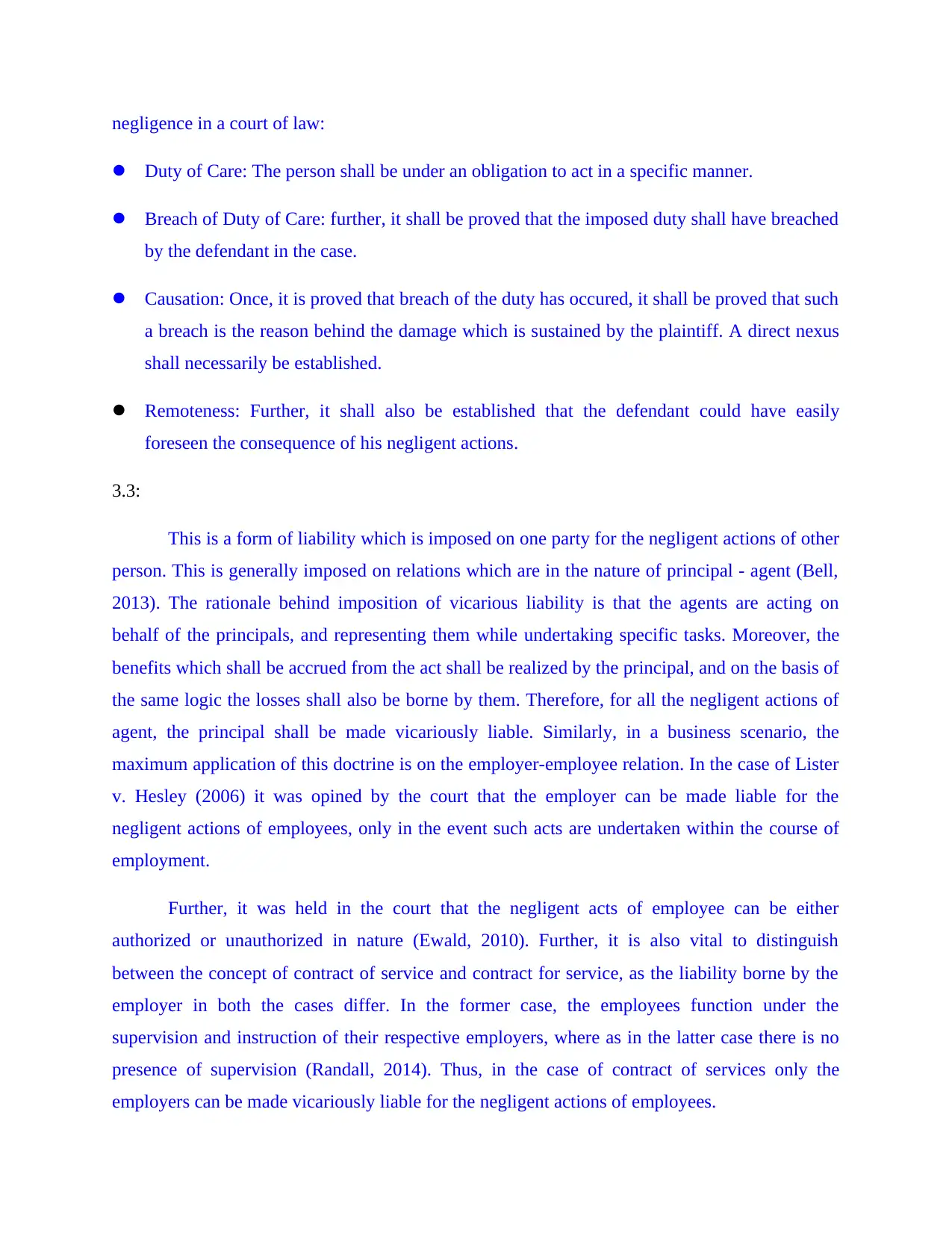
negligence in a court of law:
Duty of Care: The person shall be under an obligation to act in a specific manner.
Breach of Duty of Care: further, it shall be proved that the imposed duty shall have breached
by the defendant in the case.
Causation: Once, it is proved that breach of the duty has occured, it shall be proved that such
a breach is the reason behind the damage which is sustained by the plaintiff. A direct nexus
shall necessarily be established.
Remoteness: Further, it shall also be established that the defendant could have easily
foreseen the consequence of his negligent actions.
3.3:
This is a form of liability which is imposed on one party for the negligent actions of other
person. This is generally imposed on relations which are in the nature of principal - agent (Bell,
2013). The rationale behind imposition of vicarious liability is that the agents are acting on
behalf of the principals, and representing them while undertaking specific tasks. Moreover, the
benefits which shall be accrued from the act shall be realized by the principal, and on the basis of
the same logic the losses shall also be borne by them. Therefore, for all the negligent actions of
agent, the principal shall be made vicariously liable. Similarly, in a business scenario, the
maximum application of this doctrine is on the employer-employee relation. In the case of Lister
v. Hesley (2006) it was opined by the court that the employer can be made liable for the
negligent actions of employees, only in the event such acts are undertaken within the course of
employment.
Further, it was held in the court that the negligent acts of employee can be either
authorized or unauthorized in nature (Ewald, 2010). Further, it is also vital to distinguish
between the concept of contract of service and contract for service, as the liability borne by the
employer in both the cases differ. In the former case, the employees function under the
supervision and instruction of their respective employers, where as in the latter case there is no
presence of supervision (Randall, 2014). Thus, in the case of contract of services only the
employers can be made vicariously liable for the negligent actions of employees.
Duty of Care: The person shall be under an obligation to act in a specific manner.
Breach of Duty of Care: further, it shall be proved that the imposed duty shall have breached
by the defendant in the case.
Causation: Once, it is proved that breach of the duty has occured, it shall be proved that such
a breach is the reason behind the damage which is sustained by the plaintiff. A direct nexus
shall necessarily be established.
Remoteness: Further, it shall also be established that the defendant could have easily
foreseen the consequence of his negligent actions.
3.3:
This is a form of liability which is imposed on one party for the negligent actions of other
person. This is generally imposed on relations which are in the nature of principal - agent (Bell,
2013). The rationale behind imposition of vicarious liability is that the agents are acting on
behalf of the principals, and representing them while undertaking specific tasks. Moreover, the
benefits which shall be accrued from the act shall be realized by the principal, and on the basis of
the same logic the losses shall also be borne by them. Therefore, for all the negligent actions of
agent, the principal shall be made vicariously liable. Similarly, in a business scenario, the
maximum application of this doctrine is on the employer-employee relation. In the case of Lister
v. Hesley (2006) it was opined by the court that the employer can be made liable for the
negligent actions of employees, only in the event such acts are undertaken within the course of
employment.
Further, it was held in the court that the negligent acts of employee can be either
authorized or unauthorized in nature (Ewald, 2010). Further, it is also vital to distinguish
between the concept of contract of service and contract for service, as the liability borne by the
employer in both the cases differ. In the former case, the employees function under the
supervision and instruction of their respective employers, where as in the latter case there is no
presence of supervision (Randall, 2014). Thus, in the case of contract of services only the
employers can be made vicariously liable for the negligent actions of employees.
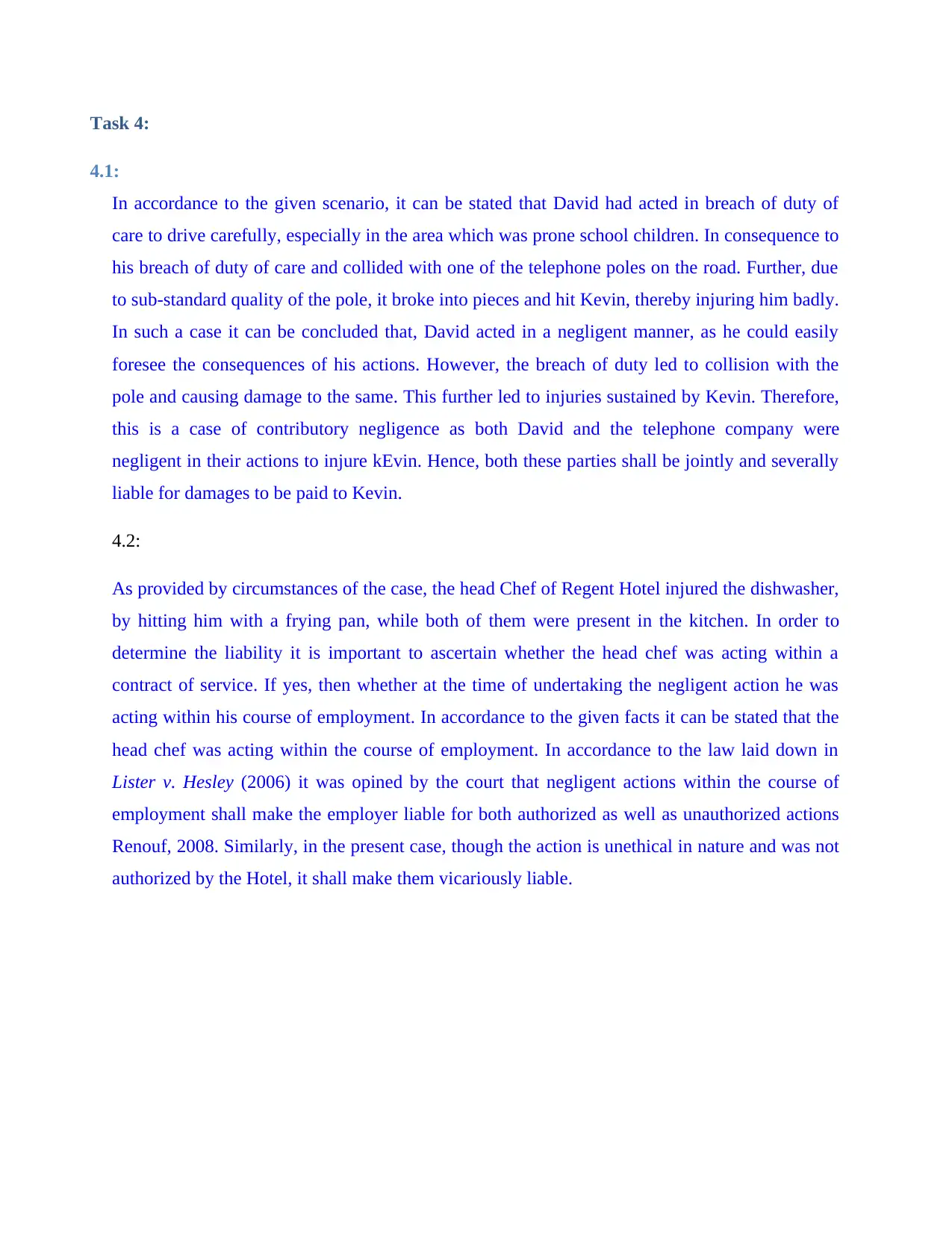
Task 4:
4.1:
In accordance to the given scenario, it can be stated that David had acted in breach of duty of
care to drive carefully, especially in the area which was prone school children. In consequence to
his breach of duty of care and collided with one of the telephone poles on the road. Further, due
to sub-standard quality of the pole, it broke into pieces and hit Kevin, thereby injuring him badly.
In such a case it can be concluded that, David acted in a negligent manner, as he could easily
foresee the consequences of his actions. However, the breach of duty led to collision with the
pole and causing damage to the same. This further led to injuries sustained by Kevin. Therefore,
this is a case of contributory negligence as both David and the telephone company were
negligent in their actions to injure kEvin. Hence, both these parties shall be jointly and severally
liable for damages to be paid to Kevin.
4.2:
As provided by circumstances of the case, the head Chef of Regent Hotel injured the dishwasher,
by hitting him with a frying pan, while both of them were present in the kitchen. In order to
determine the liability it is important to ascertain whether the head chef was acting within a
contract of service. If yes, then whether at the time of undertaking the negligent action he was
acting within his course of employment. In accordance to the given facts it can be stated that the
head chef was acting within the course of employment. In accordance to the law laid down in
Lister v. Hesley (2006) it was opined by the court that negligent actions within the course of
employment shall make the employer liable for both authorized as well as unauthorized actions
Renouf, 2008. Similarly, in the present case, though the action is unethical in nature and was not
authorized by the Hotel, it shall make them vicariously liable.
4.1:
In accordance to the given scenario, it can be stated that David had acted in breach of duty of
care to drive carefully, especially in the area which was prone school children. In consequence to
his breach of duty of care and collided with one of the telephone poles on the road. Further, due
to sub-standard quality of the pole, it broke into pieces and hit Kevin, thereby injuring him badly.
In such a case it can be concluded that, David acted in a negligent manner, as he could easily
foresee the consequences of his actions. However, the breach of duty led to collision with the
pole and causing damage to the same. This further led to injuries sustained by Kevin. Therefore,
this is a case of contributory negligence as both David and the telephone company were
negligent in their actions to injure kEvin. Hence, both these parties shall be jointly and severally
liable for damages to be paid to Kevin.
4.2:
As provided by circumstances of the case, the head Chef of Regent Hotel injured the dishwasher,
by hitting him with a frying pan, while both of them were present in the kitchen. In order to
determine the liability it is important to ascertain whether the head chef was acting within a
contract of service. If yes, then whether at the time of undertaking the negligent action he was
acting within his course of employment. In accordance to the given facts it can be stated that the
head chef was acting within the course of employment. In accordance to the law laid down in
Lister v. Hesley (2006) it was opined by the court that negligent actions within the course of
employment shall make the employer liable for both authorized as well as unauthorized actions
Renouf, 2008. Similarly, in the present case, though the action is unethical in nature and was not
authorized by the Hotel, it shall make them vicariously liable.
⊘ This is a preview!⊘
Do you want full access?
Subscribe today to unlock all pages.

Trusted by 1+ million students worldwide
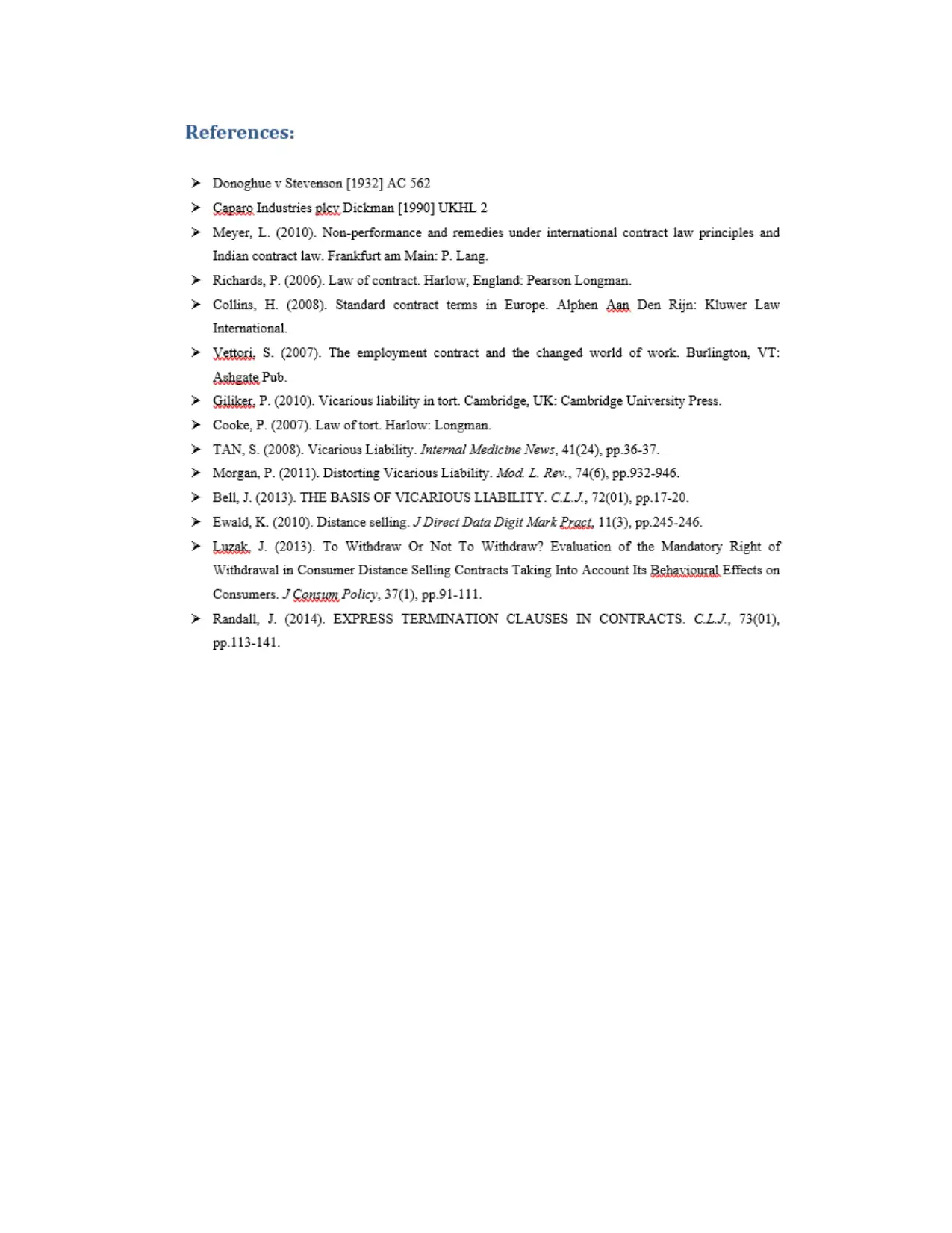
1 out of 10
Related Documents
Your All-in-One AI-Powered Toolkit for Academic Success.
+13062052269
info@desklib.com
Available 24*7 on WhatsApp / Email
![[object Object]](/_next/static/media/star-bottom.7253800d.svg)
Unlock your academic potential
Copyright © 2020–2025 A2Z Services. All Rights Reserved. Developed and managed by ZUCOL.





